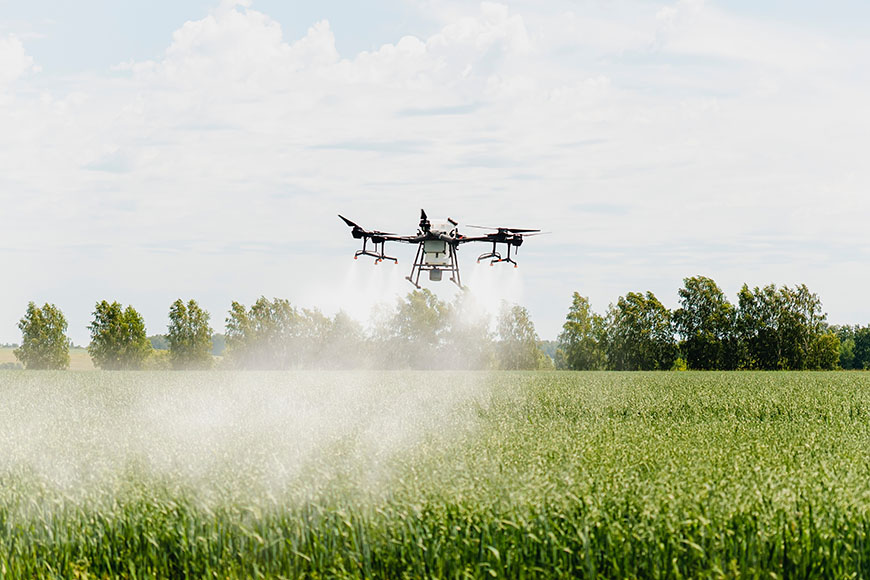Using Drones For Crop Protection Applications

When the field isn’t fit for a ground rig and an airplane isn’t feasible, drones are a great option for in-season applications. I continue to see more and more retailers and growers investing in drones, also referred to as unmanned aerial vehicles (UAV) or unmanned aerial systems (UAS), to make crop protection applications.
Today’s drones have come a long way. They’re getting larger and are able to cover more area. But it’s still a rapidly developing technology, so tomorrow’s models will likely be even more efficient and easy to handle.
Are you thinking of adding drones to your equipment inventory? Here’s what you need to know.
Drones can also be helpful for fungicide applications when corn gets too tall for a ground rig to pass through. They also reduce reliance on fixed-wing aircraft, which is especially helpful if your local applicator is booked up.
Finally, drones provide a helpful solve for hard-to-reach fields. If you have wooded areas, smaller or irregularly shaped fields that are difficult to get into, drones can get the job done. We’ve also seen a lot of range and pasture applied via drone because driving across the rough ground can be hard on equipment and the people inside.
Once you’re ready to fly it over a given field, you outline the perimeter and then the aircraft takes it from there, determining the best pattern to cover the field. The operator must maintain a direct line of site to the drone at all times. You won’t be able to stray far anyway, however, because you will need to refill the ~10-gallon tank and change out the batteries often, which typically last about 5-15 minutes. Most operators keep around three batteries and a generator ready at all times for the most efficient rotation.
Since drones require frequent refills, we often see larger quantities of spray solution pre-mixed, which then sits on the side of the field until it’s time to fill up. This can be a problem because many fungicides are formulated suspensions that settle over time and can cause problems. Make sure you're either agitating constantly or that you're mixing smaller quantities to avoid these settling issues. You don’t want solution sitting still for more than 30-40 minutes.
With the regular refills and battery changes needed, applicating via drone can be fast paced, so it’s important to get a system down that works for you to make sure you're mixing correctly every time.
MasterLock® adjuvant is a nonionic surfactant plus drift and deposition aid that works especially well with fungicides and insecticides, helping ensure active ingredients stay on target and penetrate deep into the crop canopy. For herbicide applications, StrikeLock® adjuvant is an excellent choice that combines methylated seed oil (MSO) with drift and deposition technology. If you’re applying a tank mix that already contains surfactant and MSO is not required, InterLock® adjuvant is a great option as well.
When it comes to application rates, a lot of drone-applied solutions are going out at about 2 gallons per acre. But when we’re facing tough pests like alfalfa weevil, for example, 2 gallons per acre may not be enough to provide sufficient coverage. If you’re making an application where coverage is critical, you may want to increase the carrier volume.
Drones are an exciting and emerging technology helping farmers and retailers find new ways to become even more efficient and productive. For more information or guidance on drone application best practices, contact your local WinField United retailer.
All photos are either the property of WinField United or used with permission.
© 2024 WinField United. Important: Before use always read and follow label instructions. Crop performance is dependent on several factors many of which are beyond the control of WinField United, including without limitation, soil type, pest pressures, agronomic practices and weather conditions. Growers are encouraged to consider data from multiple locations, over multiple years and to be mindful of how such agronomic conditions could impact results. InterLock, MasterLock, StrikeLock and WinField are trademarks of WinField United.
Today’s drones have come a long way. They’re getting larger and are able to cover more area. But it’s still a rapidly developing technology, so tomorrow’s models will likely be even more efficient and easy to handle.
Are you thinking of adding drones to your equipment inventory? Here’s what you need to know.
Why Are Drones Used for Spray Applications?
Getting a tractor stuck or leaving large ruts in a muddy field are never good situations. When wet conditions arise, like many have experienced this spring, drones are a great solution, allowing you to make your applications without taking a tractor across the field.Drones can also be helpful for fungicide applications when corn gets too tall for a ground rig to pass through. They also reduce reliance on fixed-wing aircraft, which is especially helpful if your local applicator is booked up.
Finally, drones provide a helpful solve for hard-to-reach fields. If you have wooded areas, smaller or irregularly shaped fields that are difficult to get into, drones can get the job done. We’ve also seen a lot of range and pasture applied via drone because driving across the rough ground can be hard on equipment and the people inside.
How Do I Make Drone Applications Operationally Efficient?
To operate a drone on your farm, you must first get licensed through the Federal Aviation Administration.Once you’re ready to fly it over a given field, you outline the perimeter and then the aircraft takes it from there, determining the best pattern to cover the field. The operator must maintain a direct line of site to the drone at all times. You won’t be able to stray far anyway, however, because you will need to refill the ~10-gallon tank and change out the batteries often, which typically last about 5-15 minutes. Most operators keep around three batteries and a generator ready at all times for the most efficient rotation.
Since drones require frequent refills, we often see larger quantities of spray solution pre-mixed, which then sits on the side of the field until it’s time to fill up. This can be a problem because many fungicides are formulated suspensions that settle over time and can cause problems. Make sure you're either agitating constantly or that you're mixing smaller quantities to avoid these settling issues. You don’t want solution sitting still for more than 30-40 minutes.
With the regular refills and battery changes needed, applicating via drone can be fast paced, so it’s important to get a system down that works for you to make sure you're mixing correctly every time.
How Can I Get the Most Out of My Drone Applications?
One of the major differences between drones and ground rigs is that drones fly 8-10 feet in the air while a ground rig stays about 20 inches above the target. Maintaining droplet sizes while applying 2-3 gallons per acre is a challenge, but it’s critical to ensure the solution can travel the 8-10 feet down to the canopy. Reducing drift and optimizing deposition are also key for successful applications. Two ways I recommend doing that are by adding the right adjuvants to the tank and fine tuning your application rate.MasterLock® adjuvant is a nonionic surfactant plus drift and deposition aid that works especially well with fungicides and insecticides, helping ensure active ingredients stay on target and penetrate deep into the crop canopy. For herbicide applications, StrikeLock® adjuvant is an excellent choice that combines methylated seed oil (MSO) with drift and deposition technology. If you’re applying a tank mix that already contains surfactant and MSO is not required, InterLock® adjuvant is a great option as well.
When it comes to application rates, a lot of drone-applied solutions are going out at about 2 gallons per acre. But when we’re facing tough pests like alfalfa weevil, for example, 2 gallons per acre may not be enough to provide sufficient coverage. If you’re making an application where coverage is critical, you may want to increase the carrier volume.
Drones are an exciting and emerging technology helping farmers and retailers find new ways to become even more efficient and productive. For more information or guidance on drone application best practices, contact your local WinField United retailer.
All photos are either the property of WinField United or used with permission.
© 2024 WinField United. Important: Before use always read and follow label instructions. Crop performance is dependent on several factors many of which are beyond the control of WinField United, including without limitation, soil type, pest pressures, agronomic practices and weather conditions. Growers are encouraged to consider data from multiple locations, over multiple years and to be mindful of how such agronomic conditions could impact results. InterLock, MasterLock, StrikeLock and WinField are trademarks of WinField United.






